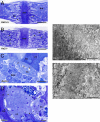Targeted disruption of the Cl-/HCO3- exchanger Ae2 results in osteopetrosis in mice
- PMID: 19164575
- PMCID: PMC2635809
- DOI: 10.1073/pnas.0811682106
Targeted disruption of the Cl-/HCO3- exchanger Ae2 results in osteopetrosis in mice
Abstract
Osteoclasts are multinucleated bone-resorbing cells responsible for constant remodeling of bone tissue and for maintaining calcium homeostasis. The osteoclast creates an enclosed space, a lacuna, between their ruffled border membrane and the mineralized bone. They extrude H(+) and Cl(-) into these lacunae by the combined action of vesicular H(+)-ATPases and ClC-7 exchangers to dissolve the hydroxyapatite of bone matrix. Along with intracellular production of H(+) and HCO(3)(-) by carbonic anhydrase II, the H(+)-ATPases and ClC-7 exchangers seems prerequisite for bone resorption, because genetic disruption of either of these proteins leads to osteopetrosis. We aimed to complete the molecular model for lacunar acidification, hypothesizing that a HCO(3)(-) extruding and Cl(-) loading anion exchange protein (Ae) would be necessary to sustain bone resorption. The Ae proteins can provide both intracellular pH neutrality and serve as cellular entry mechanism for Cl(-) during bone resorption. Immunohistochemistry revealed that Ae2 is exclusively expressed at the contra-lacunar plasma membrane domain of mouse osteoclast. Severe osteopetrosis was encountered in Ae2 knockout (Ae2-/-) mice where the skeletal development was impaired with a higher diffuse radio-density on x-ray examination and the bone marrow cavity was occupied by irregular bone speculae. Furthermore, osteoclasts in Ae2-/- mice were dramatically enlarged and fail to form the normal ruffled border facing the lacunae. Thus, Ae2 is likely to be an essential component of the bone resorption mechanism in osteoclasts.
Conflict of interest statement
The authors declare no conflict of interest.
Figures




References
-
- Tolar J, Teitelbaum SL, Orchard PJ. Osteopetrosis. N Engl J Med. 2004;351:2839–2849. - PubMed
-
- Blair HC, Teitelbaum SL, Ghiselli R, Gluck S. Osteoclastic bone resorption by a polarized vacuolar proton pump. Science. 1989;245:855–857. - PubMed
-
- Kornak U, et al. Loss of the ClC-7 chloride channel leads to osteopetrosis in mice and man. Cell. 2001;104:205–215. - PubMed
-
- Silver IA, Murrills RJ, Etherington DJ. Microelectrode studies on the acid microenvironment beneath adherent macrophages and osteoclasts. Exp Cell Res. 1988;175:266–276. - PubMed
Publication types
MeSH terms
Substances
LinkOut - more resources
Full Text Sources
Molecular Biology Databases

